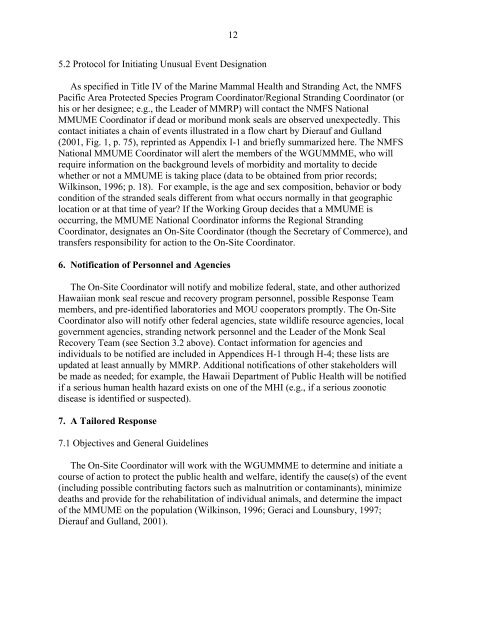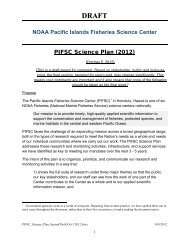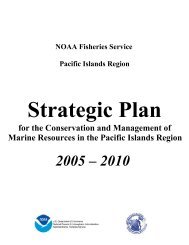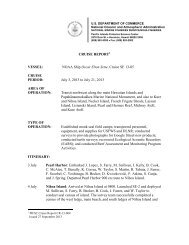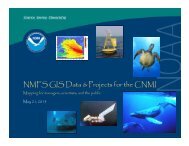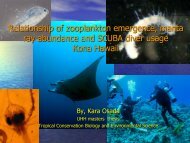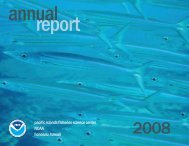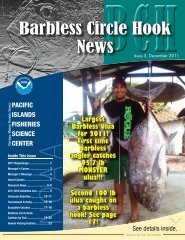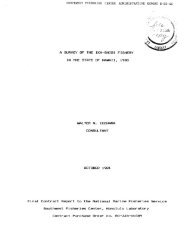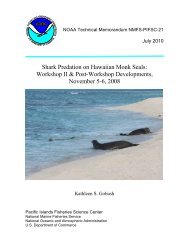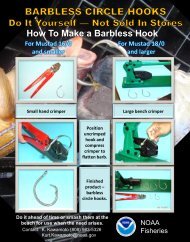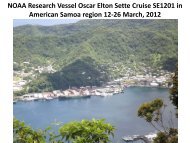Contingency Plan for Hawaiian Monk Seal Unusual Mortality Events
Contingency Plan for Hawaiian Monk Seal Unusual Mortality Events
Contingency Plan for Hawaiian Monk Seal Unusual Mortality Events
Create successful ePaper yourself
Turn your PDF publications into a flip-book with our unique Google optimized e-Paper software.
12<br />
5.2 Protocol <strong>for</strong> Initiating <strong>Unusual</strong> Event Designation<br />
As specified in Title IV of the Marine Mammal Health and Stranding Act, the NMFS<br />
Pacific Area Protected Species Program Coordinator/Regional Stranding Coordinator (or<br />
his or her designee; e.g., the Leader of MMRP) will contact the NMFS National<br />
MMUME Coordinator if dead or moribund monk seals are observed unexpectedly. This<br />
contact initiates a chain of events illustrated in a flow chart by Dierauf and Gulland<br />
(2001, Fig. 1, p. 75), reprinted as Appendix I-1 and briefly summarized here. The NMFS<br />
National MMUME Coordinator will alert the members of the WGUMMME, who will<br />
require in<strong>for</strong>mation on the background levels of morbidity and mortality to decide<br />
whether or not a MMUME is taking place (data to be obtained from prior records;<br />
Wilkinson, 1996; p. 18). For example, is the age and sex composition, behavior or body<br />
condition of the stranded seals different from what occurs normally in that geographic<br />
location or at that time of year? If the Working Group decides that a MMUME is<br />
occurring, the MMUME National Coordinator in<strong>for</strong>ms the Regional Stranding<br />
Coordinator, designates an On-Site Coordinator (though the Secretary of Commerce), and<br />
transfers responsibility <strong>for</strong> action to the On-Site Coordinator.<br />
6. Notification of Personnel and Agencies<br />
The On-Site Coordinator will notify and mobilize federal, state, and other authorized<br />
<strong>Hawaiian</strong> monk seal rescue and recovery program personnel, possible Response Team<br />
members, and pre-identified laboratories and MOU cooperators promptly. The On-Site<br />
Coordinator also will notify other federal agencies, state wildlife resource agencies, local<br />
government agencies, stranding network personnel and the Leader of the <strong>Monk</strong> <strong>Seal</strong><br />
Recovery Team (see Section 3.2 above). Contact in<strong>for</strong>mation <strong>for</strong> agencies and<br />
individuals to be notified are included in Appendices H-1 through H-4; these lists are<br />
updated at least annually by MMRP. Additional notifications of other stakeholders will<br />
be made as needed; <strong>for</strong> example, the Hawaii Department of Public Health will be notified<br />
if a serious human health hazard exists on one of the MHI (e.g., if a serious zoonotic<br />
disease is identified or suspected).<br />
7. A Tailored Response<br />
7.1 Objectives and General Guidelines<br />
The On-Site Coordinator will work with the WGUMMME to determine and initiate a<br />
course of action to protect the public health and welfare, identify the cause(s) of the event<br />
(including possible contributing factors such as malnutrition or contaminants), minimize<br />
deaths and provide <strong>for</strong> the rehabilitation of individual animals, and determine the impact<br />
of the MMUME on the population (Wilkinson, 1996; Geraci and Lounsbury, 1997;<br />
Dierauf and Gulland, 2001).


